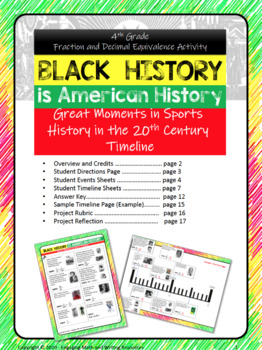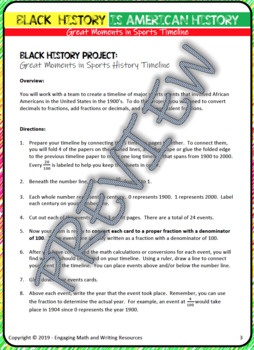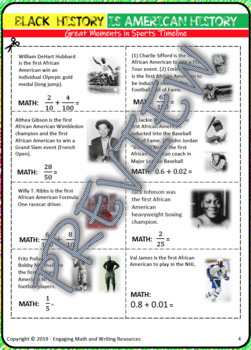Great Sports Moments Timeline - 4th Grade (Black History, Fractions & Decimals)
- PDF
Also included in
- PRODUCT 1: Journey to Equality TimelineBlack History Project – Journey to Equality Timeline(4th Grade, Fraction and Decimal Equivalence)Engaging way to practice fraction and decimal equivalence!Models, expanded form, word form, simplest form, equivalent fractions, and decimal/fraction addition and sPrice $8.00Original Price $9.50Save $1.50
Description
Black History Project –
Great Moments in Sports History in the 20th Century
(4th Grade Fraction and Decimal Equivalence)
PRODUCT DESCRIPTION:
- •Engaging way to practice fraction and decimal equivalence, equivalent fractions, and placing fractions on a number line!
- Expanded form, decimals, and fractions with denominators that are factors of 100.
- Cross-curricular way to incorporate math content into social studies!
- Print and go activity with answer key and scoring rubric included!
- Events with Jesse Owens, Muhammad Ali, Alice Coachman, Wilma Rudolph, Tiger Woods, Jackie Robinson, Ernie Davis, and many more!
One year my students begged me to give them a Black History Project like we had done the year before, but I was just teaching math at the time, and I still had skills I needed to teach. I came up with this project as a solution. I was able to incorporate the black history content into a review of fraction and decimal equivalence.
This product is a timeline project for 4th grade students that allows students to order events from African Americans’ great moments in sports in the 20th century. To order these events, students will apply their understanding of fraction and decimal equivalence to convert various forms of numbers into proper fractions with a denominator of 100. After converting the numbers to proper fractions, students will create their timeline by labeling every tenth or ten-hundredths from 0 to 1. Zero on the timeline represents the year 1900, 1 represents 2000, and 8/100 represents 1908, etc. They will need tape or glue sticks to attach the 5 number line (timeline) sheets to make one long timeline. These can be adhered to construction paper or butcher paper as well for more color and space, if desired. Students will cut out each of the 24 events and then place them in the correct area of the number line (timeline) - above or below the line. To add more rigor to this project, you can have students make their own number lines with meter sticks and a large piece of butcher/chart paper (a little over 1 meter in length). Students will have to add their own ticks on the number line (this can add about 10 minutes to the time needed for this project). I had my students work in teams of 2 or 3 to complete this project, and I checked 10 events from the timeline for accuracy, and then used the included rubric to give students a score for this project. There is also a reflection sheet at the end of the project for students to respond to what they learned.
With most projects I have my students work on, I think it is a good idea to model one or two of the event cards before students complete it on their own, but this is not necessary.
I highly recommend having students glue the included sheets on construction paper, chart paper, or butcher paper.
Related Products:
- Journey to Equality Timeline - Grade 4 (Black History with Fractions & Decimals)
- Great Sports Moments Timeline - 4th Grade (Black History, Fractions & Decimals)
- Black History Timelines Pair Pack - 4th Grade Fractions and Decimals
- Journey to Equality Timeline - Grade 5 (Black History with Fractions & Decimals)
- Great Sports Moments Timeline - 5th Grade (Black History, Fractions & Decimals)
- Black History Timeline Bundle - 5th Grade Fractions & Decimal Operations
- Black History Project - Notable People List with Descriptions
- Black History Project - Notable People List (Journey to Equality)
- Black History Project- Person Research Board or E-Presentation Graphic Organizer
- Black History Notable Person Research Project (Pair Pack)
- Mini Black History Research Project - Notable Musician Presentation
- Mini Black History Research Project - Notable Scientist Presentation
- Black History Project: Living Portraits Play
- Decimal and Fraction Equivalence Worksheets with Expanded Form & Notation
- Adding Decimals with Models Worksheet + Home Practice
- Adding Decimals with Models Sort + Practice Worksheet
- Making Big Purchases in the Real World Adding Decimals Activity
For more products, check out my TpT store!
How to get TpT credit to use on future purchases:
- Please go to your My Purchases page (you may need to login). Beside each purchase you will see a Provide Feedback button. Simply click it and you will be taken to a page where you can give a quick rating and leave a short comment for the product. Each time you give feedback, TpT gives you feedback credits that you use to lower the cost of your future purchases. I value your feedback greatly as it helps me determine which products are most valuable for your classroom so I can create more for you.
Be the first to know about my new discounts, freebies and product launches:
- Look for the green star next to my store logo and click it to be a follower. Just like that, you will now receive email updates about this store






